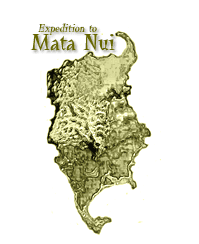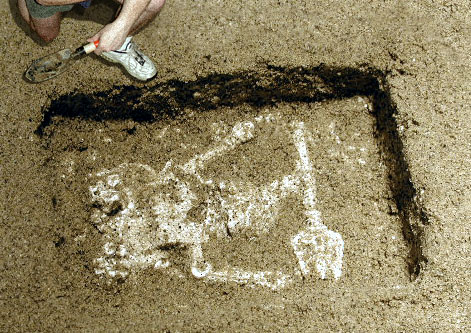Excerpts from chief researcher's daily log
June 10: Depart San Diego aboard MV Roggeveen. All supplies checked and double-checked. Anticipate smooth passage south.
June 12: Rough weather. Passage has been slower than anticipated.
June 14: Weather finally clears, making good headway.
June 18: First sighting of Rapa Nui. Made landfall and team disembarked. Toured restored village of Orongo and main village of Hanga Roa. Interviewed several storytellers who recited several versions of the legends pertaining to Mata Nui (see "storyteller transcripts"). Slept in a real bed for the first time in over a week; it felt bizarre.
June 19: Stock up on comestibles and make farewells. Villagers friendly, despite our destination.
June 20: Depart early for the last few hundred miles. Sight the island just before dusk. Despite the temptation, elect to sleep aboard and start fresh in the morning.
June 21: Set up primary camp on the southern beach, on a cove that is less forbidding than the rest of the eastern coastline.
 June 23: After securing all supplies, sent MV Roggeveen on its way. It is scheduled to return in a month and a half. We have a shortwave and satellite phone in case of emergency. Began reconnaissance of the island, using Father Benedic's description.
June 23: After securing all supplies, sent MV Roggeveen on its way. It is scheduled to return in a month and a half. We have a shortwave and satellite phone in case of emergency. Began reconnaissance of the island, using Father Benedic's description.
June 24: Discovered first settlement remains in the southwest portion of the island. Based on leaf fossils found just beneath the ever-present sand, this appears to have been heavily forested at one time. Still-standing stones indicate where possible treehouses once existed.
June 27: Three more sites mapped along the west and north coasts (slightly inland), and several black stones discovered, ranging in size from a couple of centimeters to 25 centimeters in diameter. They are oddly cold, but measurements indicate ambient temperature.

 June 28: Discovered an extremely well-preserved warrior skeleton along the mountain pass near Site 2. Took about 1 day to partially excavate using hand tools. We don't have the equipment or materials to protect and transport such a valuable find, so we are taking measurements and will re-cover after marking the spot. The figure is approx 1.8 meters tall, and is extremely regular in features, almost robotic. It is definitely not human, begging the question: is it real or a hoax? The answer will most likely have to await a visit by a trained paleoichnologist.
June 28: Discovered an extremely well-preserved warrior skeleton along the mountain pass near Site 2. Took about 1 day to partially excavate using hand tools. We don't have the equipment or materials to protect and transport such a valuable find, so we are taking measurements and will re-cover after marking the spot. The figure is approx 1.8 meters tall, and is extremely regular in features, almost robotic. It is definitely not human, begging the question: is it real or a hoax? The answer will most likely have to await a visit by a trained paleoichnologist.
 June 30: Moving up the western coastline, discovered several sets of totem rocks displaying stylized faces. Out of curiosity, one of the team (Livingstone) decided to excavate near the group. Approximately 3 feet down in the clinging sand was a small fossilized skeleton. It appeared fully grown and wounded; it was apparently buried in a defiant posture with a trident above its head. The features were closely related to the larger figure discovered along the mountainside, and both were likely interred at approximately the same time.
June 30: Moving up the western coastline, discovered several sets of totem rocks displaying stylized faces. Out of curiosity, one of the team (Livingstone) decided to excavate near the group. Approximately 3 feet down in the clinging sand was a small fossilized skeleton. It appeared fully grown and wounded; it was apparently buried in a defiant posture with a trident above its head. The features were closely related to the larger figure discovered along the mountainside, and both were likely interred at approximately the same time.
 July 5: A shallow indentation in a basalt cliff face hid a rock surprisingly similar to a moai from Rapa Nui. The carved face lies supine and is covered with the most complete selection of the puzzling glyphs found scattered elsewhere throughout the island. We have made rubbings and will attempt translation at a later time.
July 5: A shallow indentation in a basalt cliff face hid a rock surprisingly similar to a moai from Rapa Nui. The carved face lies supine and is covered with the most complete selection of the puzzling glyphs found scattered elsewhere throughout the island. We have made rubbings and will attempt translation at a later time.
July 7: Minor scuffles between the team have broken out. Tensions are high, for no apparent reason. The only interesting thing happening in the last day has been mapping a large concentration of shiny black rocks.
July 10: Masks keep popping up. At least 6 distinct types, in different sizes. No indication as to what they were meant for.
 July 11: The cliff face at site 5 continues to fascinate. Not only is the workmanship superb, it appears that at one time one or more waterfalls cascaded from the mouth! This level of workmanship was completely unexpected. Scrambling to the base of the cliff is not difficult, but there are many loose stones, one of which turned Ephrom Childs' ankle, putting him out of commission for a week. (Note: remember to never have Ephrom assigned to KP again. Thank God there are no roaches on this island.)
July 11: The cliff face at site 5 continues to fascinate. Not only is the workmanship superb, it appears that at one time one or more waterfalls cascaded from the mouth! This level of workmanship was completely unexpected. Scrambling to the base of the cliff is not difficult, but there are many loose stones, one of which turned Ephrom Childs' ankle, putting him out of commission for a week. (Note: remember to never have Ephrom assigned to KP again. Thank God there are no roaches on this island.)
 July 13: Stayed at a bluff with some stone lintels still standing. It is a spectacular sight, and is without a doubt the most relaxing area on the entire island.
July 13: Stayed at a bluff with some stone lintels still standing. It is a spectacular sight, and is without a doubt the most relaxing area on the entire island.
 July 18: Dr. Livingstone stumbled, quite literally, into a major find this morning. She twisted her knee by stepping into a partially-obscured tread track. The fossilized track marks were formed by a very heavy machine rolling through and compressing what appeared to have been fertile soil. A short distance away is another curious fossil, containing a "face" much like the first large figure, sans mask.
July 18: Dr. Livingstone stumbled, quite literally, into a major find this morning. She twisted her knee by stepping into a partially-obscured tread track. The fossilized track marks were formed by a very heavy machine rolling through and compressing what appeared to have been fertile soil. A short distance away is another curious fossil, containing a "face" much like the first large figure, sans mask.
 July 22: Manet uncovered a large, well-preserved fossil that resembled a large wing, near the site of the track tread and circular face. This supposed "wing" would have covered as much as a 12-foot wingspan, if indeed it is a wing. The team is not convinced, although Manet maintains his first analysis. The number of large and well-preserved fossils in this concentrated area indicates a major series of events, which the team has discussed in depth. An hypothesis is forming, but it is too fantastic to note here.
July 22: Manet uncovered a large, well-preserved fossil that resembled a large wing, near the site of the track tread and circular face. This supposed "wing" would have covered as much as a 12-foot wingspan, if indeed it is a wing. The team is not convinced, although Manet maintains his first analysis. The number of large and well-preserved fossils in this concentrated area indicates a major series of events, which the team has discussed in depth. An hypothesis is forming, but it is too fantastic to note here.
 July 27: Nearing the end of our expedition; the ship will return next week. Bickering has reached an all-time high, fueled by some of the remarkable things we've seen on this island. The only place where we seem to get along is the northern arch bluff, which Michelle has nicknamed "Xanadu".
July 27: Nearing the end of our expedition; the ship will return next week. Bickering has reached an all-time high, fueled by some of the remarkable things we've seen on this island. The only place where we seem to get along is the northern arch bluff, which Michelle has nicknamed "Xanadu".
July 28: Michelle spent several hours clearing away all the obsidian shards in a several hundred meter area around the camp. It kept her busy and the rest of us were able to get some work completed. I had supposed she was part of the problem, but when she returned she took a nap and we had the first calm meal in weeks. Tonight we actually had a singalong.
Aug. 1: Packing up, ready to return. Collating notes. Very busy picking up loose ends. Looking forward to a real bed.
Aug. 3: The Roggeveen returned this morning. Spent all day loading. The team collated notes, and after much heated discussion, have settled on the conclusions. They are, well, unconventional.




